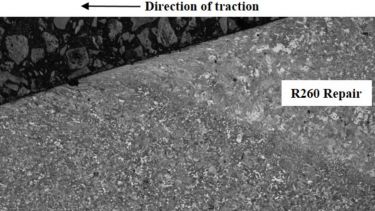Additive manufacturing for railway track component life extension
The scope of this research is the application of laser cladding additive manufacture to repair or enhance the performance of rail steels with respect to wear and rolling contact fatigue damage. Methods are developed to characterise the novel material properties and plastic ratcheting is quantified.

The lifespan of conventional grades of rail steel is limited by wear and rolling contact fatigue, and rails can be costly to repair or replace. Additive manufacturing of premium rail materials with higher yield points that are more resistant to plastic damage could potentially increase the life of rails at locations particularly susceptible to damage. Laser cladding offers a feasible method of in-situ additive material application in targeted areas. This study assesses laser clad low carbon Martensitic Stainless Steel (MSS) alloy with 14.64% chromium as a material for repair of railway track components considering also the effect of the substrate rail material on the overall performance.
The laser clad coating’s resistance to strain presents challenges in characterisation, so a novel method was developed to extract the Shear Yield Stress – Plastic Shear Strain (SYS-PSS) relationship from a minimal number of twin-disc tests. A further set of short twin-disc tests were conducted to determine the rate of strain accumulation within the materials. These experiments provided the data required to quantify plasticity using an empirical ratcheting model. It was found that due to the higher yield stress of the new and novel rail materials that smooth Hertzian contact pressures could not predict the depth and magnitude of near surface plastic ratcheting observed in the laser clad coating and substrate rail. The modelling technique was extended with incorporation of a surface roughness model to evaluate the contact pressures which cause the plastic deformation in the top few microns of the laser clad coated rails and a study into the surface topography was conducted. The asperity peak wavelength and asperity tip radius were calculated from roughness measurements and used to calculate the asperity contact parameters.
The findings show that laser clad coating has strong potential as an enhancement process for railway track component life extension using Martensitic Stainless Steel (MSS) alloy with 14.64% chromium. The laser process parameters and the depth of laser clad coating must be carefully controlled to achieve the desired quality: if the coating is too thin and the peak contact stress occurs below it, plastic shear strain accumulates within the substrate. The low levels of plastic shear strain observed in this work indicates that the wear and RCF performance will be improved compared to conventional rail steels. There is potential to reduce rail replacement frequency if applied to areas of rail prone to damage. There is further potential to utilise the laser clad coating method for in-situ repairs. Tests indicated that a repair with the same material as the parent rail was most effective. This was because both repair and substrate have comparable plastic ratcheting rates, prevented material flow of the parent rail over the repair site, and reducing crack initiation points. The geometry of the repair must be carefully controlled to avoid a thin layer of clad material creeping along the rail surface due to plasticity in the substrate.
Funding: This work was supported by Industrial Case (Cooperative Awards in Science and Technology) studentship number 17100018 with the EPSRC (Engineering and Physical Sciences Research Council) National Productivity Fund and Network Rail.
People involved
Dr Katherine Tomlinson
